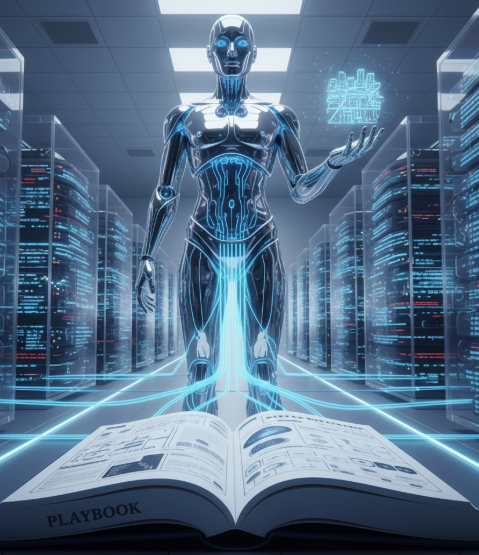A Practical Playbook for Building Trustworthy AI Agents

We've grown accustomed to AI that provides answers.
We ask a question, and a large language model synthesizes information to give us a remarkably human-like response. But we are now standing at the threshold of a monumental shift: the leap from AI that knows to AI that does.
This is the dawn of agentic AI.
Imagine spilling a drink on the floor. You say, "I spilled my drink, can you help?" and a robot in your home doesn't just process the words; it understands the situation. It reasons that a spill needs to be cleaned, finds a cloth, wipes the floor, identifies the potential slip hazard, locates a "wet floor" sign, and places it appropriately.
This isn't science fiction. This is the capability being developed in labs like Google DeepMind with their Gemini-powered robotics. Agentic AI can take complex, multi-step commands, reason about the physical world, and execute a plan of action.
The potential to help in our homes, factories, hospitals, and countless other environments is immense.
But this new power carries with it a profound responsibility. Taking these systems from a controlled lab to the chaotic, unpredictable real world is one of the most significant safety and trust challenges of our time.
How do we ensure these agents are not just capable, but are fundamentally helpful, harmless, and trustworthy?
Based on the critical work being done by leading researchers, here is a practical playbook for the responsible deployment of agentic AI.
---
The Bedrock of Safety: From Code to Constitution
In the past, robot safety was often a matter of rigid, hard-coded rules: "If sensor X is triggered, stop motor Y." This approach is brittle and cannot scale to handle the infinite complexities of the real world.
The new paradigm is Constitutional AI.
This means embedding a core set of principles - a constitution - directly into the model's foundation using natural language. This constitution acts as a built-in conscience, guiding the agent's reasoning process. Principles can be simple but powerful:
"Do no harm to humans."
"Avoid actions that could damage property."
"Do not perform actions involving live electricity or open flames."
By making safety a fundamental part of the AI's "character," we create a system that is inherently safer and can generalize its principles to novel situations it has never encountered before. Safety ceases to be a feature added on top; it becomes the bedrock upon which all other capabilities are built.
---
The Guardian in the Loop: The Power of Meaningful Human Oversight
The ultimate goal isn't blind autonomy; it's effective human-robot collaboration. One of the most critical safety mechanisms is ensuring there is always a "human in the loop" for complex, novel, or potentially irreversible actions.
This is more than just a stop button. Meaningful human oversight means the AI agent is designed to recognize the limits of its own certainty. When faced with an ambiguous command or a high-stakes decision, the system should be programmed to pause and ask for confirmation.
For example, if a user says, "Throw away everything on this table," an agent with proper oversight wouldn't just start sweeping objects into the trash. It would reason that a laptop and a set of keys are likely valuable and pause to ask, "I see a laptop and keys. Are you sure you want me to throw those away as well?"
This collaborative checkpoint serves two purposes: it prevents costly errors, and more importantly, it builds trust. It assures the user that they are in ultimate control, with the AI acting as a capable partner, not an unchecked actor.
---
The Search for Failure: Why We Must Try to Break Our Own Creations
The only way to build a truly robust system is to proactively and relentlessly try to break it. In the world of security and AI safety, this is known as red-teaming.
Before any agentic AI is deployed, it must undergo rigorous testing in controlled, simulated, and real-world environments. This isn't just about testing if the robot can perform a task correctly; it's about creatively searching for ways it could fail.
What happens if you give it a contradictory command?
How does it react to a sudden change in its environment, like a person walking in front of it?
Can its vision system be fooled by confusing objects or poor lighting?
This process of institutionalized skepticism is crucial for identifying biases, safety gaps, and unintended consequences before they can cause harm. Every failure discovered in the lab is a real-world accident prevented.
---
Building the Guardrails Together: The Mandate for Open Collaboration
The challenge of deploying agentic AI safely is too large for any single company to solve alone. Just as the aviation industry collaborated over decades to create a shared ecosystem of safety standards - from air traffic control protocols to maintenance checklists - the AI and robotics community must do the same.
This requires a profound commitment to open collaboration.
Research labs, academic institutions, and industry competitors must work together to:
Share findings on safety and ethical challenges.
Establish common benchmarks for evaluating robot performance and safety.
Develop universal best practices and open standards that can lift the entire industry.
When it comes to safety, we cannot afford to have walled gardens. The public's trust in this technology will not be determined by the best actor, but by the worst. A collective effort to build and share the fundamental guardrails is the only way to ensure the entire field moves forward responsibly.
The Trust Imperative
We are on the cusp of an incredible new chapter in the human-machine partnership. Agentic AI and robotics have the potential to enrich our lives, boost our productivity, and help us solve some of our most pressing challenges.
But this future is not guaranteed. It must be built on a foundation of unwavering commitment to safety, ethics, and transparency. The ultimate measure of success will not be the capability of our creations, but their trustworthiness.